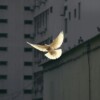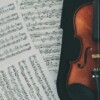Click here to listen to the episode on Spotify
In the fourteenth episode of the second season of the “Saturdays at Seven” conversation series, Todd Ream talks with Morten Lauridsen, Distinguished Professor of Composition Emeritus at the University of Southern California. They open their conversation by talking about Lauridsen’s practice of going down deep, the role that practice plays in his ability to appreciate what a particular text has to offer, and how he sets that text to music. To cultivate a more contemplative and environmentally responsible campus, the value of that practice compelled Lauridsen to lead the charge at the University of Southern California (USC) to eliminate gas powered leaf blowers. The value of that practice also led Lauridsen to spend time on Waldron Island in Washington State’s San Juan Islands where Lauridsen composed some of his most critically acclaimed works. Lauridsen then discusses his calling to compose music, efforts he made when an undergraduate to study at USC, and efforts he made while serving as a faculty member and chair of the composition department at USC (efforts that included establishing the graduate program in film scoring). Lauridsen discusses the details related to some of his compositions including “Lux Aeterna” and “O Magnum Mysterium.” Ream and Lauridsen then close their conversation by discussing the ways poetry played critical roles in Lauridsen’s efforts as a teacher and composer.
- Morten Lauridsen’s “Four Madrigals on Renaissance Texts,” Performed by the USC Thornton Concert Choir
- Morten Lauridsen’s “Les Chansons des Roses,” Performed by the Chamber Choir of Europe
- Morten Lauridsen’s “Lux Aeterna,” Performed by the Los Angeles Master Chorale
- Morten Lauridsen’s “Mid-Winter Songs,” “Performed by the USC Thornton Chamber Singers
- Morten Lauridsen’s “O Magnum Mysterium,” Performed by the Los Angeles Master Chorale
Todd Ream: Welcome to Saturdays at Seven, Christian Scholar’s Review’s conversation series with thought leaders about the academic vocation and the relationship that vocation shares with the Church. My name is Todd Ream. I have the privilege of serving as the publisher for Christian Scholar’s Review and as the host for Saturdays at Seven. I also have the privilege of serving on the faculty and the administration at Indiana Wesleyan University.
—
Our guest is Morten Lauridsen, distinguished Professor of Composition Emeritus at the University of Southern California. Thank you for joining us.
Morten Lauridsen: I’m delighted to join you this morning, Todd. I’m happy to chat with you about my music and poetry or whatever else you would like.
Todd Ream: Thank you. I want to start by asking about an article that I read recently dated back to 2021. The University of Southern California posted it on its website, touting the fact that the university park campus there just south of downtown Los Angeles had become the first campus green zone in the country.
The process was 12 years in the making and it began with the transition to electric leaf blowers that led to an annual reduction of 89 tons of greenhouse gas and 15 tons smog forming exhaust, as well as a quieter and more contemplative campus. By chance, do you know anything about what may have led President Steven B. Sample to begin that process?
Morten Lauridsen: I sure do, because I led that charge. I sent Stephen Sample, the president of the university, a letter saying, this very morning, I’m talking about music with my theory class at 8 o’clock in the morning. And there are two guys outside with leaf blowers, gasoline-powered leaf blowers, blowing dirt around and what somebody’s dog had for dinner last night into the air. And I can’t hear my own students. I cannot hear the music I’m being played for them. And it’s ridiculous to have these gas-powered leaf blowers on this quiet campus.
They have been banned illegal in the city of Los Angeles, but somehow the University of Southern California is ignoring that ban. I said, this is a place of, of thinking, of solitude. There is no reason to have these things disrupt our air, disrupt our our, noise, etc. And I demand that they be replaced by either rakes or the much less polluting electric leaf blowers.
Well, that began a series of conversations that lasted for many, many months, where I went to war with the university over these things, ending with, I would resign from the university if they didn’t initiate this. And I would go on every TV and media outlet I had to say that the University of Southern California cares more about blowing this crap around in the air than the health and welfare of tens of thousands of students and faculty.
And it finally ended with the letter. Just before I was going to resign and denounce the university publicly. A handwritten letter from the head of grounds crews there. saying Mr. Lauridsen please don’t resign, don’t quit your thing. We have found that we can get cheaper, and effective electric leaf blowers.
And so this is the start of all of that. And when they, in that 2021, I think article, I think that the fellow mentions that there was some professor that started it all off with a letter to the president of the university. And I implore people around the country to get rid of these infernal machines. They do nothing but pollute the air, wreck our noise, and progressive communities throughout the country have said, use electric ones or use rakes, but these things are simply dreadful in all ways.
So I’m very happy to have initiated that at USC. And now they brag about the fact that they’re so green. They weren’t always that way.
Todd Ream: Thank you, thank you. No, that’s an important and also a humorous story too, I think both in there at the same time. But also, you know, contributing to, you know, what not only led to what they now offer as a green campus, but also a more quiet campus.
And I want shift now by asking you about another place and space that is important to you. Roughly 1300 miles north of Los Angeles is Waldron Island, Washington with a population of approximately 100 to 104, give and take on any given day, this 4.6 square mile island in the San Juans became a sacred space for you. Would you please describe how your relationship with Waldron Island began?
Morten Lauridsen: Absolutely, I’m happy to do that. Well, I was raised in Portland, Oregon and my aunt and uncle lived in Bellevue, Washington and they bought a beachfront property on this very, very remote island in the San Juan Islands. This is an island that when I first went to it in 1952, as a kid, I was nine years old only had 11 people on it, no electricity, no communication with the outside world, other than a mail boat that would come three times a week to the island to deliver mail.
And I bonded with this island, the quietness, the serenity and it was a sanctuary for me actually in, in many ways. My father was one of the most abusive SOBs that ever walked this planet, and I was glad to get away from his constant physical and mental abuse to find sanctuary on this island. And as a child, I would go up there each summer and spend some time in this beautiful, beautiful, serene, unspoiled, quiet place.
Well, my aunt and uncle sold, they made a home there and they sold it in the 1960s after my uncle got some health issues. And I was finally able to find a place for sale which was quite unique. It was an abandoned general store on the waterfront. This place had been abandoned for 25 years. At one time, Walden Island had 400 inhabitants because there was a quarry there And this place was at one time in the 1920s a general store, but it had become abandoned.
And when I bought it, there were no windows or doors. It’d been picked over by the islanders. It was filled with bats and rats and bird nests and all that. Well, I moved in there after I bought it 1975 with a $50 piano that I had barged up to the island, a golden retriever, some hand tools, a sleeping bag, and a little Coleman stove, and it just started at the doorway. Of course, there was no door there.
And over the years I did a couple of major things. I transformed this abandoned shack that was falling down into a very comfortable, livable, rustic cabin, two-story cabin for my family. I have three sons. And I also did something else. On that $50 piano, in the quietness of this island, I wrote a great deal of music, including, finishing off, “O Magnum Mysterium,” “Lux Aeterna,” “Prayer,” and other, other works that have become now world-famous.
And it’s just me and this, this piano, sitting in this shack by the beach, with the only outside noise being the wind, the sound of eagles, the lapping of waves at the shore. And in the serenity, the calmness of this place, I was able to go down deeply within myself and set texts, such as the “O Magnum Mysterium and the “Lux Aeterna,” that have now resonated with people all over the world.
Todd Ream: That phrase that you just used, going down deep. Would you please unpack more what you mean by such a phrase and what sort of habits of heart and mind make going down deep possible for you?
Morten Lauridsen: First of all, I learned years and years ago, after a season of fighting forest fires up in Washington State, I was posted on a lookout in the Gifford Pinchot National Forest one of these things on a tower. I was all alone for 10 weeks at that time and made the monumental decision for me, and I was just beginning my sophomore year, to go into music, which I had not done at that time, and to go back and try and find my journey with music.
But in the solitude, in the quietness up there on that tower of, of having introspection and finding out that at that particular time that I missed music so much that I had to get involved with it in some way.
And it’s the same way on the island by, by going down deep, you’re able to do introspection and sometimes this introspection, especially in my case, being a product of an abusive childhood, to simply able to set that aside and to go through painful stuff and to get through that so I can go down to the place where I can deal with my art free of those kinds of things.
And, it was especially necessary for me in setting these very, very, timeless and meaningful texts, from the Latin Bible about the birth of Christ, about eternal light shining upon those departed souls. It was important to, to put everything else aside and to go down and to try and get to the crux of what that all meant. And I was able to do that on Walden Island, and I’m so thankful that I had that particular experience.
And I must say, in all my talks that I give all over the world, I encourage students and listeners to find a place like that, to find a place of quietness, away from cell phones and all this other stuff, because you lose your identity if you’re constantly dealing with these outside distractions. You need to find your true self in the quietness and serenity. And I implore everybody to try and find a space that they’re able to do that.
Yeah, so Waldron Island was deeply important to me. And as a result of that, I think produced the music that is now done and appreciated all around the world.
Todd Ream: Thank you. Yeah, it’s beautiful. Thank you very much.
You mentioned that you grew up in Oregon and initially attended Whitman College and you were just talking about that experience on that lookout tower that you spent 10 weeks on near Mount Saint Helens that summer. Would you say a little bit more about what it was that led you to feel called, believe you were called music and how it became that, that thing which you could not do?
Morten Lauridsen: Yes. Well, I was a good pianist growing up. I studied piano. I was a fair, better than average, I think, trumpet player. I played classical and jazz, and loved to, to play in dance bands but I always thought that this would be an avocation. I thought that, you know, like most people enjoy playing the piano in off hours, but I didn’t see it as a career because I thought that a career in music would be associated with being a performer. And I really didn’t want to be a performer.
But I knew that music was calling me and that’s hard to put into words. I remember Piatigorsky, the great cellist, was asked if his children went into music, and he said no because they haven’t gotten the sting of the bite of music that draws them in. And I felt it on that island, I mean on that lookout tower. I came off of that tower feeling that music was compelling me in some way to make it my career, and I did not know in which direction that would be.
So I simply, at that time, went back to Whitman College, a very fine liberal arts college, and took every single music class I could, you know, the history, and the theory, and the ear training, and you name it. But then I made a decision that if I were to do this, I needed to go to a school of music where I could take many, many classes that would help me forge my own journey into music, because I didn’t know what it was. And I also wanted to go to a place where there were concerts constantly, so I could hear live music. And that was not happening in Walla Walla, Washington.
So, at the recommendation of many, many people, I decided to transfer down to the University of Southern California. My parents, of course, were very upset with me that I made that decision. My mother’s parting words as I got into my 1953 Buick to drive down from Portland, Oregon to Los Angeles to enroll at USC were these, and after 60 years they still ring clear as a bell in my mind. She said to me, when it doesn’t work out, you can always come home and eat crow.
Well, I told her two things. I’m going to go down there because I feel compelled to do that, as all artists are. They’re compelled to do something, but especially, I said, I’m very, very well aware of the number of people going down to L.A. or New York to become a musician or an artist of any sort, an actor, that the fail rate is very high, probably you know, 97 percent or something like that.
But I said, I’m not going to look back on my life as an old man and say why didn’t I have the guts to believe in myself that I could do this and I’m not going to look back on my life and say, I should have had the courage to make this move when I was young and able to do that. So I said, I’m going to go back down there and I’m going to give it my best shot and I might fail and if I do, don’t worry about me. I’m no dummy. And I love history. I love English. I’ll find a place somewhere. And then the last thing I said to her whatever happens, crow ain’t on my menu.
And I went down there and I wish she were alive today to see what’s happened with my career. You know, the last piece of mine that she heard, and it was only on tape, was the tape of the premiere of the “O Magnum Mysterium.” She heard that and she said, I would love to have that at my funeral, which actually happened just a few months after that.
So I salute all of you people, you are my heroes, that you go down and give it your best shot to follow your dream. And as you well know, it takes a lot of extra innings, the fear of rejection, dealing with economics. I mean, God, you know, I lived, I lived in the ghetto for years in Los Angeles. In those years, hawking my trumpet, or my flugelhorn, or my typewriter, to get ten bucks, and ten bucks back in the 70s went a long way. But it depended upon whether I was going to do a gig, or write a term paper, which one got hawked.
But I persevered. I believed myself. So I started late. I was put in the beginning composition class, if you can believe this, as a junior because I did not have a portfolio of compositions. And the head of the composition area at USC, the very distinguished professor, Halsey Stevens, gave me one semester to see if I could cut it or not, back in those days.
And as history shows, I eventually succeeded him as Chair of the Composition Department at USC. And as a way of paying him back for his graciousness in letting me enroll in a composition class. When he came down with a severe case of Parkinson’s later on in his life, it was terrible he was on L Dopa and he couldn’t even eat. It was just awful. He asked me to go to his studio, composition studio, and find pieces that he had begun when he was healthy. And he asked me to finish them for him in his style. And I spent two years of my life that. So you hear his “Viola Concerto.” His “Four Songs of Love and Death,” “Venite Exultemus,” his seventh piano, “Sonatina.” I finished them all.
It has his name, his composer, and simply says, edited by me. But he heard them all before he died, and he could never tell the seam where, where he ended and I began. So it’s a way of repaying this great man for his contributions in so many ways to me and to the musical world, yeah.
Todd Ream: Thank you. Yeah, it was a beautiful gift that he gave you and you gave in return, him in that sense.
Before we talk about some of your compositions, I wanted to ask you, you mentioned that you served as chair of the department, the composition department and also helped establish the film scoring program. What vocational satisfaction did serving in those roles and establishing such a program provide you?
Morten Lauridsen: Huge, especially the Advanced Film Scoring Program. Now picture this— about 1985 or so, I went to the dean of the School of Music and said to him, what is wrong with this picture? We’re 50 feet from one of the most acclaimed film college, schools, anywhere on the planet, the USC film Department of Film. We live in Hollywood. And so many of the students who come through the composition program here at USC want to score films. We don’t have a program to do that.
We had one basic class taught by the great David Raksin but it was only meant once a week, and it was mainly the history and then we, we did little scenes, composed them. I said, what we need is a graduate level program, a certificate program in film scoring, taught by the best people that we can find in the industry. And he liked the idea.
It took me two years to establish that, running it through all those committees at the University of Southern California, but we established it. And went out and hired Jerry Goldsmith and David Raksin and, and Elmer Bernstein, and so many others to teach these classes. And I’m so proud of starting that out. And now it is among the most elite programs anywhere in the world. A lot of programs, a lot of people rank at the finest in the world. And we’re able to place all of our graduates in film scoring.
Now look, the fellow who just wrote, got the Grammy and every other thing, it’s the Oscar for Oppenheimer, that’s one of our students, came through that program. And I can remember, personally admitting Marco Beltrami to the program who’s gone on to a fabulous career. There are 16 to 20 students each year in this program. It’s now a year-long program that has also evolved into a master’s degree program.
And I’m just so proud of that program to make available for students from all over the world to come and study with some of the finest people in Los Angeles and to walk into Paramount Studios and saying I went to the USC Film Scoring Program and that’s an immediate entry for that. So I’m delighted with that, oh my gosh. I was certainly would have taken it as a kid myself. But it wasn’t available, but I made it possible for others to take it.
And I’m so delighted. After wonderful things happened to my music back in the late 90s, I was approached by the Vice President of Sony Music, come score films for us. And I said, you know, I would have all those years ago, but at this point in my life, I don’t have the time for that. I’m running the show there at USC. At that particular time, I’d been appointed composer in residence with the Los Angeles Master Chorale, which was hugely important for me.
So, I wasn’t able to do that, but I also chaired the Department of Composition at USC for a dozen years. Very proud of that. For all the students we put through there and the programs I initiated, little did we know from getting into that Buick all those years ago that I’d still be at USC and finally appointed Distinguished Professor. That’s a very high honor at USC. There are over 4,000 faculty and there are only about 25 of us Distinguished Professors. And that came after getting the National Medal of Arts in the White House. And so it all worked out very, very well.
Todd Ream: We should be all be grateful that the Buick didn’t leave you somewhere stranded outside of Stockton perhaps on your way down then. And it got you to Los Angeles.
Morten Lauridsen: It got me to L.A. but it did leave me stranded here and there, an old car like that. It was the right choice to make to go down to Los Angeles and I was so far behind all the other students. Look, the students that I was, got into the class with had been writing music for years, even as kids. And I didn’t have anything.
But I’ll tell you what. I applied myself very hard, and was taught with brilliant people at all levels, including Harold Owen, my first year of composition who went on to have a distinguished teaching career at the University of Oregon. But Ingolf Dahl and Halsey Stevens and Robert Linn. And so pleased when they asked me to stay on the faculty. I did do that. Finally, I was able to move out of the ghetto.
Todd Ream: You mentioned that you’d served with the Los Angeles Master Chorale and have held appointments as far from Los Angeles as say the University of Aberdeen. In addition to the habits of heart and mind that make going down deep possible, would you please talk about your experience composing, and what role in particular do texts say, such as poetry play in that experience?
Morten Lauridsen: Well, first of all, for composers, I remember one of the teachers I studied with, Ingolf Dahl, when he would talk to composers, he would address them saying, you are the elite. You have to know more than anybody else. You’re starting with a blank piece of paper, and you have to know it all, history, theory, orchestration, counterpoint, you name it. And you have to be able to put it all together to create something.
And my second love, for years, was poetry. And my first love, musically, was the sound of the human voice. The most basic, primal instrument that we all have. And to combine the sound of the human voice with poetry was perfect for me. So I ended up writing a whole number of songs of mixed duets and choral music.
And as you know from looking at my catalog of poets, I went to those poets whose work deeply resonated with me and who all spoke to essential facets of the human condition, life, death, love, lost and gained, quietness, introspection, all, all of these kinds of things. And I found that in the poems of some of the greatest poems that ever walked on the earth, Rilke, Neruda, Eiji, Witt, Gioia, Moss, reading poetry every day.
And I should mention that I taught at USC. I taught college classes at USC for 52 years before I retired, and the vast majority of those classes were always started with a poem. It elevates you. It takes, I tell my music students, poets are dealing with words the way we are dealing with notes. Now, listen to these poets.
And I would start these classes with poetry and, and my students would assemble poems and I would start the class saying, who’s got a poem for us today? And someone might say, well, I’ve got one. It’s about walking in woods in the snow evening. And we’d simply read it, discuss it briefly, and then go on to the music. And I was so proud of that and the students loved it. In fact, one of the classes at the end of the term gave me a whole book of poems that they had composed for me.
I still get emails from students from decades ago saying I’m still reading my Neruda, still reading my Rilke. And I invite everybody to do that. For imagination I would go to Rilke. For love, I would go to Neruda. Boy, those 100 love sonnets he wrote to his wife, Cien Sonatos.” Ah, I set two of them, find me a better love poem, love sonnet than this, where he starts out saying, “When I die, I want your hands upon my eyes. I want to feel their freshness one more time.”
And he goes on to say in this sonnet, “even though I’m dead, I will wait for you. In the meantime, I want you to blossom into full bloom. I want you to feel the sun on your hair, and the wind on your back, and the sand on your feet, and to flower into full bloom. And in the meantime, everyone’s going to know the reason for my song.” It simply doesn’t get any better than that. It simply doesn’t. So, I’m enriched with this constantly.
I’m reading poetry constantly. And I’m so happy to give attention to these wonderful poets. Most recently, of course, the Great Poet Laureate of the State of California, Dana Gioia, who ran so successfully the NEA for so many years. I set a poem that he wrote about the death of his firstborn son from SIDS at four months old Sudden Death Infant Syndrome. They don’t know what causes that still to this very day.
But a very complex poem where he, the first part of the poem, you don’t know quite where he’s going with the poem because there’s all these images like footsteps in the alleyway and so on. You don’t know quite where he’s going. And then finally he implores that whatever is out there, be it spirits, or God, or nature, whatever, to watch out for his little boy for him. It just breaks your heart. And you ought to see the mail that we’ve gotten, both Dana and I, from that poem and for that musical setting, from parents who have lost their child to SIDS.
Or the mail that I’ve gotten, of course, on the “O Magnum Mysterium,” “The Lux Aeterna,” “The Lux Aeterna.” 30 minute piece for choir and orchestra with text from the, from the Latin Bible, all relating in some way to this image of eternal light shining upon them. And I wrote it for those left behind, for the living, to bring them comfort and strength. And I wrote them as a result of getting the news that my own mother was dying.
And so we as artists, we go to those things that will give us strength. And I was with the L.A. Master Chorale, and the great conductor, Paul Salamunovich, who was an expert on Gregorian chant and the Latin liturgy. He was a choir director at a Catholic church for 60 years.
And then became appointed to conduct the L.A. Master Chorale, and they appointed me as their first Composer in Residence. And so I chose Latin texts, and wrote music that was right up his alley, that had its roots in chant, with language in Latin, on, on deeply meaningful texts. And after I was appointed asked to be the first Composer in Residence of the L.A. Master Chorale back in the 1990s.
The president of the Master Chorale asked me if I could possibly write my first piece for their Christmas concert. And I said, yeah, I can do that. And so my first piece was “O Magnum Mysterium.” And that was a good start. And then we went on to “The Lux Aeterna” and “Ave Maria.” And then the L.A. Master Chorale recorded a full album of my music that got a Grammy nomination so, off we went with that. And but it was a great joy in my life for six or seven years being the Composer in Residence with this wonderful 120 voice professional chorus that now, of course, sings at Walt Disney Hall.
And in fact, just yesterday, did a piece of mine there. They did Les Chansons des Roses – Dirait-on, from Dirait-on from Les Chansons des Roses on Rilke, and then, very recently, did a performance of the “O Magnum Mysterium” to mark the 30th anniversary of its premiere, all those years ago, back in 1994. So it was a great joy for me to be associated with the L.A. Master Choir. And also at USC. They had fabulous choirs there, and the chamber choir at USC premiered the “Mid-Winter Songs” of poems by Robert Graves and “The Madrigali,” the six fire songs on Renaissance Italian poems. And so I was very lucky as a composer who was interested in writing for chorus to be surrounded with fabulous choruses in Los Angeles.
And of course this is the reason I went down there, to become exposed to music of all kinds. And it was a good choice. And despite what my mother said I made it work.
Todd Ream: I want to take you back, if I may, to your very first composition that was rooted in your reflections on Psalm 150. What led you to that text at that particular point in time when the success of your music was still out there in the future and you were finding your own voice and your own technique and what contribution you would make.
Morten Lauridsen: Well, I was raised in the Congregational Church in Beaverton, Oregon, just outside of Portland. And sang in the church choir. And so I was very, very familiar with the Bible passages and all that. And so, as an undergraduate, in the second year of my instruction down there, as a student in the class, we’re asked to write a choral piece. And so I immediately thought of the Psalms and especially Psalms 150 where it talks about making music with the trumpets and other instruments and so on. And so I thought that that would be a great text to set.
So I set it acapella, just the voices. And it’s a very, fast little setting of this, takes only three minutes or so. And I was so lucky to be at that time singing in the USC Concert Choir. And I had the manuscript of my setting of Psalm 150. And I showed it to the director of the choir. And he looked at it and said, “You know what? I’ll tell you what we’re going to do. We’re going to take this piece on tour and you’re going to conduct it.”
What a great gift that was. I mean, I was just beginning. I can remember, I mean, the piece has changing meters, right? It might go from 3/4 to 4/4 to 3/8 and so on all the way through. And I never conducted anything in my life, but I was in a conducting class at that time.
And I remember taking my piece back home, getting in front of a mirror with a conducting stand and trying to conduct this piece and saying, now, how does five go, is this, is two on the left and two on the right, or how’s that thing? And then saying, who wrote this piece of music with all these changes in it?
But I did conduct it. And we took it on tour and it was very successful. And then, I sent it off to Augsburg Publishing House in Minneapolis. And they had a series of, they call it Contemporary Settings of the Psalms. And so my very first choral piece got published by Augsburg. And that was a great thrill.
And also, I told you before, I, at one time, played the trumpet. And we were assigned to write a trumpet sonata, and this was, once again, in our second, second year of composition class as an undergraduate. So I wrote for the two instruments I could play very well, trumpet and piano. So I wrote a sonata, and it was premiered by a freshman student there at that time, who I heard warming up outside before his lesson.
He was simply playing scales and runs and all that. And I went up to him and I said, I don’t know who you are, but I’m writing a trumpet sonata, and I’d love to have you premiere it. And he did. And his name was Ronald Romm, who then went on for years as the first trumpet in the Canadian Brass. And is now retired. Yeah, and then that got published.
So, from going from nothing, from zero, being put in a composition class at the very beginning. Within two years, I had two published pieces. And the faculty down at USC took notice of that and said, “Well, the green thing from Oregon seems to have some talent.” And then they kept me on. It was a large enough school I could study with different people at different levels. And they kept me on through the doctorate and then they hired me to stay and teach.
Little did I know from driving down in that Buick, living in the ghetto in the place that we called Wacky Manor, it was just a nut place a big place with a bunch of music students in it that I would then again have a long, long, long career at the University of Southern California and then at the LA Master Chorale.
Todd Ream: Thank you.
Our guest has been Morten Lauridsen, Distinguished Professor of Composition Emeritus at the University of Southern California. Thank you for sharing your insights and wisdom with us.
—
Thank you for joining us for Saturdays at Seven, Christian Scholar’s Review’s conversation series with thought leaders about the academic vocation and the relationship that vocation shares with the Church. We invite you to join us again next week for Saturdays at Seven.
























It was my privilege to sing Lux Aeterna as part of our Regent University choir, twice in the last year. THANK YOU for this interview!
Regarding a quiet place to compose (or for me, to pray, work, or write)–and prophesying Lauridson’s fight against the noise of gas-powered lawn equipment!–Gilbert Kaplan (a lay conductorr of Mahler’s 2nd) wrote this of Mahler’s composition of his 2nd at his tiny composing cottage on Lake Attersee in Steinbach, Austria in the summer of 1893:
“Mahler required absolute silence when he composed, so he always kept the windows of his little cottage closed. ‘I am certain,’ he said, ‘that in some future age the human race will be as sensitive to noise as it is now to smells, and that there will be the heaviest possible penalties and public measures to forbid offenses to the hearing.’ He wrote to a colleague about his ‘summerhouse (in the meadow), just built, an IDEAL place for me! Not a sound for miles around! Surrounded by flowers and birds (which I do not hear, but only see).’ As a further effort in noise control his two sisters and his brother were constantly trying to keep farmers and children away. Bells were removed from wandering cows and brightly colored clothing was hung in nearby fields to frighten away birds whose calls were especially distracting to Mahler. During one noteworthy walk, however, a few shrieking birds flew up in front of Mahler, and he captured those sounds for the Second Symphony” (Gilbert Kaplan, “The Birth of a Symphony,” CD program booklet, “Mahler Symphony No. 2 ‘Resurrection,’ London Symphony Orchestra, Gilbert Kaplan, MCA Classics MCAD 2-11011(Universal City, CA: Atlantis Music, Ltd., 1988), 27-28.
THANKS again for this marvelous interview!